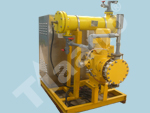| MARINE VESSELS
|
The antifouling properties are guaranteed by the sodium hypochlorite which produced from the electrolyzer; while the continuous water flow and the low concentration of hypochlorite allow reducing the hydrogen concentration and the high aggressiveness properties of the solution.
The complete reaction 2 NaCl + H2O --> NaOCl + NaCl + H2 describes how the solution salt + water, of which seawater is composed of, produces hypochlorite, salt and hydrogen through a simple electrolytic process continually nourished by the passage of the current through the electrolyzer.
It's also interesting to note that when the electrolysis has taken place the solution reverts to salt and water within 10 - 20 minutes.
Further more the plant ensures periodical cycles of automatic cleaning to protect the anodes from the encrustations and extend the duration up to 2 years at work.
Because of the following reasons electrochlorinator (sodium hypochlorite generator), manufactured by M/s. Ti Anode Fabricators Pvt Ltd., India - is to be installed in on board.
|
- Antifouling in Sea Chests:
Cleaning of the sea chests by leading chlorinated discharge water through sea chests.
- Prevention of biological mud formation:
Elimination and prevention of biological mud formation inside refrigerants and condensers in which seawater circulate.
- Deodorization & Disinfection:
Deodorization and disinfection of the sanitary services. The antifouling treatment eliminates also putrefaction (causes horrible smells) that occurs in the sanitary pipes especially on old ships.
- Prevention of Mussels:
Prevention and elimination of mussels (shells etc.), barnacles, seaweed etc. formation in the pipes where seawater passes, in particular in narrow passages.
- Antifouling treatment serves to maintain clean for instance:
- Cooling engine circuits, condensers, generators, refrigerators, fire control.
- Location of anti roll fins.
- Cooling system of the shaft line supports etc..
|
| Tiaano ECU 0.05 consisting...
|
- Power Supply:
It pumps the Direct Current to the electrolyzer, receives alarm signals from the peripheral parts of the plant, and optionally it control the distribution of the solution in the different parts of the board.
- Chlorine Generator:
It is an assembly of electrolyzer, generates the NaOCl from the seawater, equipped with titanium pressure / flow switch for the regularization of seawater.
- Valve Box & Injection Point (optional):
Provides the distribution of the NaOCl in the different sea chests and can be manually or automatically controlled.
|
Supply of spare parts...
|
- Replacement cells.
- Plant refurbishment and Retrofit of latest technology upgrade to older installations.
- Service Contracts including Planned Preventative Maintenance.
- Maintenance Work for Convenience.
- Operation & Maintenance Training.
- On-site Inspection & Survey.
- Warranty part service.
|
| System Standards
|
| Tiaano® ECU Models |
Available Cl2
per hour (Kgs) / Hr |
Sea Water in M3 |
| Minimum flow rate |
Treated with 0.5 ppm |
| Tiaano® ECU 0.05 S / 0.050 |
0.05 |
1.5 |
100 |
| Tiaano® ECU 0.05 S / 0.125 |
0.125 |
1.5 |
250 |
| Tiaano® ECU 0.05 S / 0.250 |
0.250 |
2.9 |
500 |
| Tiaano® ECU 0.05 S / 0.350 |
0.350 |
4.0 |
700 |
| Tiaano® ECU 0.05 S / 0.500 |
0.500 |
5.7 |
1000 |
| Tiaano® ECU 0.05 S / 0.750 |
0.750 |
5.7 |
1500 |
| Tiaano® ECU 0.05 S / 1.000 |
1.000 |
5.7 |
2000 |
|
Note: Non standard Electro chlorinators will be designed, based on customer’s specification.
|
Back to Chlorinators
|
|

Anode for Seachest
Chlorination
|

Anode for Seachest
Chlorination
|

Chlorinator for Oil Tanker Vessels
|

Replacement of our Electrolyzers in Cruise Ship
|

Tubular Electrolyzer for
Naval ship
|

Electrolyzers for Passenger Ships
|

Electrolyzers for
Ballast Water Treatment
|
|